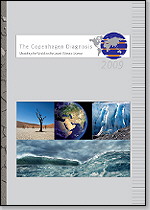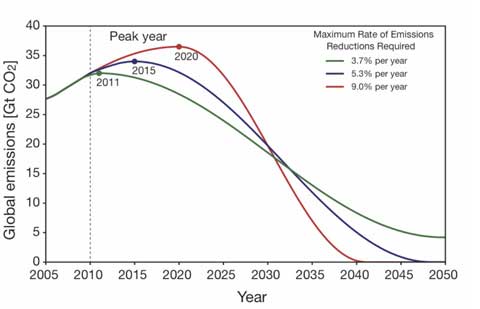Exciting new concepts in earth systems science are emerging from the fertile intellect of one of Hot Topic’s most diligent readers, Ian Wishart. Either that, or he’s demonstrated (again) that he doesn’t understand what he’s writing about. In this astonishing post, published yesterday, he considers something he calls the “feedback warming effect”, and attempts to use a new paper on carbon cycle feedbacks to support Monckton’s nonsense on climate sensitivity.
Just as Chicken Little pontificates about the minutiae of a Monckton allegation about warming amplification being overestimated by six of seven times, along comes a new study in Nature that compared real data with the computer models and found CO2’s feedback warming effect has been exaggerated in the models by five or six times.
Monckton’s TV lies are not mentioned — minutiae to Wishart, obviously — but he then points to this paper: Ensemble reconstruction constraints on the global carbon cycle sensitivity to climate, Frank et al, Nature, 2010; 463 (7280) as if it offers support for Monckton. It doesn’t, as I shall explain, but is Wishart wrong about Monckton, wrong about Frank et al, or both?
Monckton’s “paper”, Climate Sensitivity Reconsidered, is about what it says it is — the global temperature response to (by definition) a doubling of CO2 in the atmosphere. Monckton tries, and fails, to show that this response is small — he claims under 1ºC at doubling. Wishart refers to climate sensitivity as “warming amplification”, which — to be charitable — is a terminological inexactitude.
Frank et al, on the other hand, is the latest effort to pin down how much extra CO2 will be released from the various parts of the carbon cycle as global temperature increases, and suggests that it could be smaller than had been expected [Science Daily]. This “extra” CO2 clearly is an amplification of warming caused by human emissions, and it’s good news that this may be smaller than expected. Wishart describes the study thus:
…[it] compared real data with the computer models and found CO2’s feedback warming effect has been exaggerated in the models by five or six times.
What did Frank et al actually do? Physics World describes their method:
… David Frank and colleagues at the Swiss Federal Research Institute in Birmensdorf, the University of Bern and the Gutenberg University in Mainz have performed the most comprehensive analysis of carbon dioxide and temperature data yet. The team studied the period 1050–1800 AD, when manmade emissions were small enough to be ignored. Carbon dioxide levels were determined from three Antarctic ice cores. Average temperatures in the northern hemisphere were derived from nine different “proxy reconstructions” of temperature – average temperatures derived mostly from tree rings and the isotopic content of ice cores.
No comparisons with models, but a lot of use of paleoclimate data — you know, the tree ring stuff you find in those “debunked” hockeystick blades — and ice cores (and in Wishart-world they can’t be trusted, because Wishart relies on the “work” of EG Beck). Frank and his co-workers use this data to try to work out how much extra CO2 is released when the planet warms — and find that instead of the 40 ppmv/ºC found in previous empirical studies, it was more likely to be in the range 2–21 ppmv/°C, with 8 ppmv/°C being the most likely. The BBC asked Frank what this means for model projections of temperature change this century:
He said that if the results his paper were widely accepted, the overall effect on climate projections would be neutral.
“It might lead to a downward mean revision of those (climate) models which already include the carbon cycle, but an upward revision in those which do not include the carbon cycle.
“That’ll probably even itself out to signify no real change in the temperature projections overall,” he said.
Wishart doesn’t seem to have much of a handle on carbon cycle feedbacks and what they mean for model projections, but he’s canny enough to spot that someone might quibble with his penetrating analysis, so he includes this caveat:
A note for the pedants: the Monckton claim and the Nature paper are approaching a similar problem (magnitude of feedback warming) from slightly different directions (Monckton’s comment relates to rise in temp caused by doubling of CO2, whilst the Nature paper examines the increase in CO2 caused by a rise in temperature), but the general thrust of the arguments is similar: extra carbon dioxide is not going to cause as much feedback as previously claimed.
Clear as mud, Ian. This pedant would point out that the problems being considered are not the same and the “general thrust of the arguments” is not at all similar. Monckton isn’t talking about “feedback warming”, he’s talking about warming caused by a fixed increase (by definition a doubling over pre-industrial conditions) in CO2. He wants us to believe that the temperature response to increasing CO2 is tiny. On the other hand, Frank et al’s conclusions are based on linking small changes in global temperature over the period from 1050 to 1800 to small increases and decreases in CO2 levels.
In other words, if Monckton is right, then Frank et al’s methodology can’t work. Far from supporting Monckton, Frank et al add yet more reasons why he has to be wrong. Meanwhile, Wishart is wrong on all counts. I wonder how such an expert climate commentator could have failed to notice? Perhaps he should get his stuff peer reviewed. Where’s Monckton when you need him…?


 The Copenhagen climate conference (
The Copenhagen climate conference (


 The last time CO2 hit a sustained level of 400 ppm 15-20 million years ago global average temperatures were 3 – 6ºC warmer than now, and sea level was 25 to 40 m higher, according to
The last time CO2 hit a sustained level of 400 ppm 15-20 million years ago global average temperatures were 3 – 6ºC warmer than now, and sea level was 25 to 40 m higher, according to